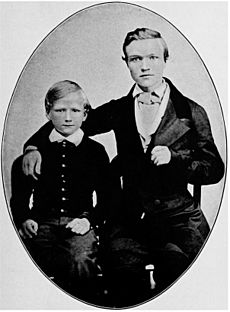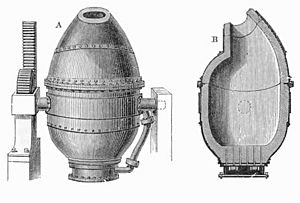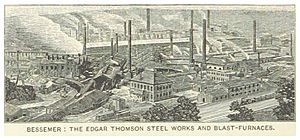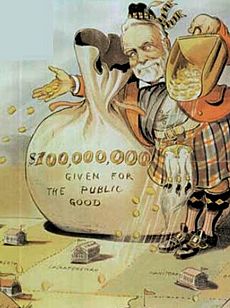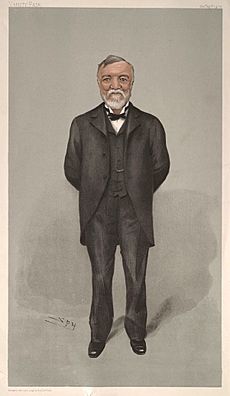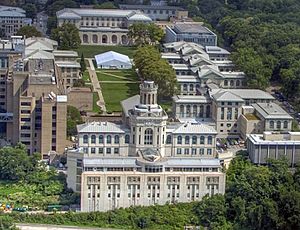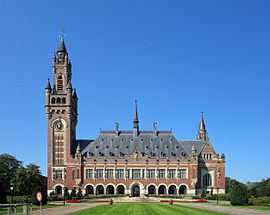Andrew Carnegie facts for kids
Quick facts for kids
Andrew Carnegie
|
|
|---|---|
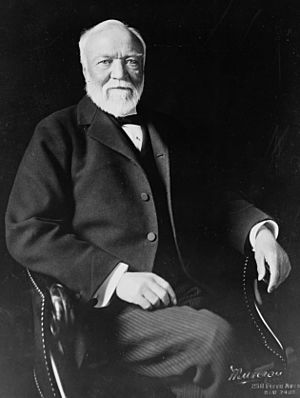
Carnegie in 1913
|
|
| Born | November 25, 1835 Dunfermline, Fife, Scotland
|
| Died | August 11, 1919 (aged 83) Lenox, Massachusetts, U.S.
|
| Resting place | Sleepy Hollow Cemetery, Sleepy Hollow, New York, U.S. |
| Occupation | Industrialist, Philanthropist |
| Known for | Founding and leading the Carnegie Steel Company Founding the Carnegie Library, Carnegie Hall, Carnegie Institution for Science, Carnegie Corporation of New York, Carnegie Endowment for International Peace, Carnegie Mellon University, Carnegie Trust for the Universities of Scotland, Carnegie United Kingdom Trust, Carnegie Foundation for the Advancement of Teaching, Carnegie Council for Ethics in International Affairs, Carnegie Museums of Pittsburgh, and the Carnegie Hero Fund |
| Political party | Republican |
| Spouse(s) | |
| Children | Margaret Carnegie Miller |
| Parent(s) | William Carnegie Margaret Morrison Carnegie |
| Relatives | Thomas M. Carnegie (brother) George Lauder (first cousin) George Lauder Sr. (uncle) |
| Signature | |

Andrew Carnegie was a famous American businessman and philanthropist. He led the huge growth of the American steel industry in the late 1800s. He became one of the richest Americans ever.
Carnegie was also a major philanthropist in the United States and Great Britain. In the last 18 years of his life, he gave away about $350 million. This was almost 90 percent of his wealth. He gave it to charities, foundations, and universities. In his 1889 article, "The Gospel of Wealth", he said that rich people should use their money to make society better. He believed in taxes on wealth and encouraged many others to give to charity.
Contents
Andrew Carnegie's Life Story

Andrew Carnegie was born in Dunfermline, Scotland. His parents were Margaret Morrison Carnegie and William Carnegie. He went to the Free School in Dunfermline.
His uncle, George Lauder Sr., was a big influence on him. His uncle taught him about Scottish heroes like Robert the Bruce and William Wallace. When Andrew was 12, his father, a handloom weaver, lost his job. The family was very poor. His mother started selling potted meats to help. The Carnegies decided to borrow money and move to Allegheny, Pennsylvania, in the United States in 1848. They hoped for a better life there.
Starting Work in America
In September 1848, Andrew and his family arrived in Allegheny. Andrew's first job was at a cotton mill. He was a bobbin boy, changing spools of thread. He worked 12 hours a day, 6 days a week. He earned $1.20 per week.
Soon, he got a better job for $2.00 per week. He worked for John Hay, who made bobbins.
In 1849, Andrew became a telegraph messenger boy in Pittsburgh. He earned $2.50 per week. He worked very hard and learned all the business locations in Pittsburgh. He also learned to understand telegraph signals by ear. Within a year, he became an operator.
Andrew loved to read and learn. A man named Colonel James Anderson opened his personal library to working boys. Andrew borrowed books often. He was very thankful to Colonel Anderson. He promised himself that if he ever became rich, he would help other poor boys get similar chances.
Working for the Railroad
In 1853, when Andrew was about 18, he got a job with the Pennsylvania Railroad. He worked as a secretary and telegraph operator. He earned $4.00 per week. He saw more chances to grow his career at the railroad.
By age 24, Andrew became a superintendent for the railroad. He earned $1500 a year. He hired his younger brother, Tom, and his cousin, Maria Hogan. Maria became the first female telegraph operator in the country. Working for the Pennsylvania Railroad was very important for his future success. He learned a lot about managing big businesses and controlling costs.
His boss, Thomas A. Scott, also helped him with his first investments.
Before the American Civil War, Carnegie invested in a company that made sleeping cars. These cars made long-distance travel easier for first-class passengers. This investment was very successful for Carnegie.
During the Civil War, Carnegie helped with military transportation. He supervised the Union Government's telegraph lines. He helped open rail lines into Washington D.C. and managed the transport of troops. The telegraph service he organized helped the Union win the war.
Building a Steel Empire
The Civil War showed how important industries like steel and railroads were. In 1864, Carnegie invested in an oil company. This company made a lot of money. The demand for iron products during the war made Pittsburgh a center for production. Carnegie started investing more in the iron industry.
After the war, Carnegie left the railroads to focus on ironworks. He started companies like Keystone Bridge Works. He used his connections with the Pennsylvania Railroad to get contracts for his companies. He even named his first steel plant after his former boss, J. Edgar Thomson. Carnegie was good at business and charming. He used his social connections to his advantage.
Carnegie's Keystone company supplied the steel for the famous Eads Bridge across the Mississippi River in St. Louis. This bridge, finished in 1874, showed that steel technology was reliable. It opened up a new market for steel.
Carnegie believed in using his wealth to help others. He wrote that he wanted to earn no more than $50,000 a year. He wanted to spend the rest of his money on good causes. He felt that making too much money could be bad for a person. He planned to retire at 35 to focus on education and helping the poor.
Carnegie made his fortune in the steel industry. He controlled the largest steel operations owned by one person in the U.S. He had two main innovations:
- He used the Bessemer process to make steel cheaply and efficiently. This process removed carbon from pig iron quickly. This made steel prices drop.
- He used vertical integration. This meant he owned all parts of the steel-making process. He owned the raw materials, the railways, and the steamships.
By the late 1880s, Carnegie Steel was the biggest maker of steel in the world. By 1889, the U.S. made more steel than the UK, and Carnegie owned a big part of it. His empire included many steel plants and mines. In 1892, he combined all his businesses into the Carnegie Steel Company.
Carnegie's success also came from his close ties with the railroad industry. Railroads needed steel for tracks and also transported steel. Carnegie and other powerful businessmen worked together to set prices. Carnegie also spent money to convince Congress to keep tariffs (taxes on imported goods) high. This helped his steel business earn millions of dollars each year.
Selling His Company and Retirement
In 1901, Carnegie was 65 and thought about retiring. He turned his businesses into regular companies. J. P. Morgan, a powerful banker, saw how profitable Carnegie's company was. Morgan wanted to create one giant steel company to lower costs and prices.
Morgan bought out Carnegie and other steel producers. On March 2, 1901, he formed the United States Steel Corporation. It was the first company in the world worth over $1 billion. This was the biggest industrial takeover in U.S. history at the time. Carnegie's share was about $225.64 million, paid in gold bonds. After this, Carnegie retired from business.
A Great Philanthropist
After retiring in 1901, Carnegie spent the rest of his life giving away his fortune. He had written about his ideas on wealth in books like Triumphant Democracy and Gospel of Wealth. He believed that wealthy people should use their money to help society and improve education. He kept letters of thanks from people he helped in a drawer labeled "Gratitude and Sweet Words."
He gave money to many causes, including a movement to simplify spelling.
Building Libraries for Everyone
One of his most famous acts of charity was building public libraries. He was inspired by Enoch Pratt, another philanthropist who built a library in Baltimore.
Carnegie funded about 3,000 libraries in the United States, Britain, Canada, and other English-speaking countries. His rule was that he would pay to build and equip the library. But the local community had to provide the land and money for the library's daily operations.
He gave $500,000 to Pittsburgh for a public library in 1885. He also gave money for libraries and music halls in Allegheny City and Edinburgh. His libraries helped make free books available to many people.
-
Edinburgh Central Library
-
Yorkville Library, Ontario.
-
Carnegie Library at Syracuse University, New York
-
Carnegie Library, Moorreesburg, South Africa
Supporting Education, Science, and Peace
In 1900, Carnegie gave $2 million to start the Carnegie Institute of Technology (CIT) in Pittsburgh. In 1902, he gave another $2 million to start the Carnegie Institution in Washington, D.C., to encourage research. CIT is now known as Carnegie Mellon University.
He also gave $10 million in 1911 to the Carnegie Institution to help build the Hooker Telescope at Mount Wilson. He wanted to see the results from it before he died. The telescope saw its "first light" in 1917, while Carnegie was still alive.

In 1901, he gave $10 million to start the Carnegie Trust for the Universities of Scotland. This trust helped improve scientific research and allowed more young people in Scotland to go to university. He also gave a lot of money to his hometown of Dunfermline. He bought Pittencrieff Park and opened it to the public. A statue of him was built there.
Carnegie loved music. He helped fund the National Conservatory of Music of America. He also built Carnegie Hall in New York City, which opened in 1891. He even paid for 7,000 pipe organs to be built in churches and temples.
In 1913, he gave another $10 million to start the Carnegie United Kingdom Trust. This foundation helped with rural libraries and music education.
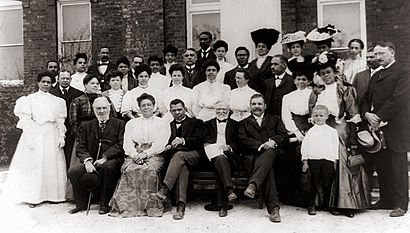
Carnegie also set up pension funds for his former employees and for American college professors. He was a big supporter of the Tuskegee Institute for African-American education. He worked with Booker T. Washington to create the National Negro Business League.
In 1904, he created the Carnegie Hero Fund for the United States and Canada. This fund recognized brave acts of heroism. He also donated money to build the Peace Palace at The Hague in the Netherlands and a Pan-American Palace in Washington.
When he realized he couldn't give away all his money during his lifetime, he created the Carnegie Corporation of New York in 1911. This foundation continues his work of promoting knowledge and understanding.
Andrew Carnegie was seen as a humanitarian who used his wealth to help others. Some people say he represents the "American dream" because he came from a poor background and became very successful, then gave most of his money away.
Death

Andrew Carnegie died on August 11, 1919, in Lenox, Massachusetts. He died from pneumonia. He had already given away over $350 million. After he died, his remaining $30 million was given to foundations, charities, and pensioners. He was buried at Sleepy Hollow Cemetery in Sleepy Hollow, New York.
Personal Life
Carnegie did not marry until after his mother passed away. In 1887, at age 51, he married Louise Whitfield, who was 21 years younger than him. In 1897, they had their only child, a daughter named Margaret, after Carnegie's mother.
Legacy and Honors

Carnegie received many honors for his charity work. He received honorary degrees from several universities, including the University of Glasgow and the University of Aberdeen. He was also given the "Freedom of the City" in several Scottish cities. In 1910, he received the National Order of the Legion of Honour from France.
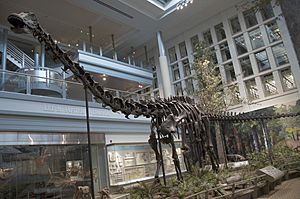
- A dinosaur, Diplodocus carnegiei, was named after him. Carnegie paid for the expedition that found its remains. He was so proud of this dinosaur, nicknamed "Dippy," that he had copies of its skeleton sent to museums around the world.
- After the Spanish–American War, Carnegie offered to donate $20 million to the Philippines so they could buy their independence.
- The towns of Carnegie, Pennsylvania, and Carnegie, Oklahoma, are named in his honor.
- The Saguaro cactus's scientific name, Carnegiea gigantea, is named after him.
- The Carnegie Medal for the best children's books in the UK is named after him.
- The Carnegie Faculty of Sport and Education at Leeds Beckett University in the UK is named after him.
- Concert halls in Dunfermline and New York are named after him.
- At the peak of his career, Carnegie was the second-richest person in the world, after John D. Rockefeller.
- Carnegie Mellon University in Pittsburgh was named after Carnegie, who founded it as the Carnegie Technical Schools.
- Lauder College in Dunfermline was renamed Carnegie College in 2007.
- A street in Belgrade (Serbia), near one of the Carnegie libraries, is named after him.
- Carnegie Vanguard High School in Houston, Texas, is named after him.
Images for kids
-
Carnegie, right, with James Bryce, 1st Viscount Bryce
-
Andrew Carnegie with his wife Louise Whitfield Carnegie and their daughter Margaret Carnegie Miller in 1910
-
The Andrew Carnegie Mansion, located on 5th Avenue in the Upper East Side, Manhattan, New York
See also
 In Spanish: Andrew Carnegie para niños
In Spanish: Andrew Carnegie para niños


